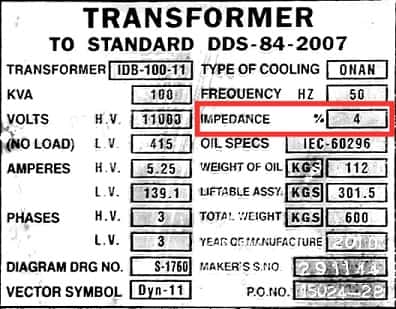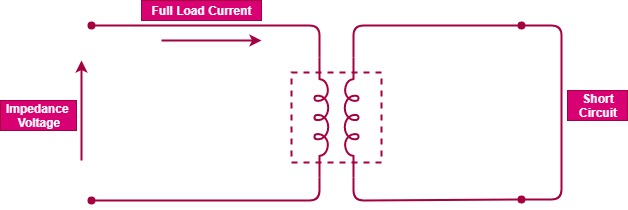AC MACHINES-1 (66761) Theory
4. Understand equivalent circuit of transformer, magnetic leakage and leakage reactance of transformer.
4.9. Define percentage resistance, reactance and impedance.
“The percentage impedance is nothing but a measure of the volt drops when the transformer in on full load due to the winding resistance and leakage reactance ...
The percentage impedance of a transformer (Z%) is the voltage drop on full load due to the winding resistance and leakage reactance expressed as a percentage of the rated voltage.
The percentage impedance of a transformer is marked on most nameplates – but what is it and what does the Z% figure mean?
When referring to the impedance of a transformer, it is the equivalent impedance that is meant.
It is marked in percentage value on the nameplate of power transformers in every electrical substation.

Percentage Impedance in Nameplate of an 11kV/415V Transformer
Calculation of Percentage Impedance
In order to determine equivalent impedance, one winding of the transformer is short-circuited. And a just enough voltage is applied to the other winding to create full load current to flow in the short-circuited winding.
This voltage is known as the impedance voltage.

Percentage impedance of transformer testing
Either winding may be short-circuited for this test, but it is usually more convenient to short circuit the low-voltage winding.
The nameplate of a transformer shows its impedance value in percent. This means that the voltage drop due to the impedance is expressed as a percent of rated voltage.
Read More Here: How to Test Percentage Impedance of Transformer?
Example Calculation
Example Calculation
For example, if a 2,400/240-volt transformer has a measured impedance voltage of 72 volts on the high voltage windings, its impedance (Z), expressed as a percent, is:
Z% = (Impedance Voltage / Rated Voltage) x 100
percent Z = (72/2400)*100 = 3 percent
This means there would be a 72-volt drop in the high-voltage winding at full load due to losses in the windings and core. Only 1 or 2% of the losses are due to the core; about 98% is due to the winding impedance.
Z = V/I
If the full load current is 10 amps:
Z = 72V/10A = 7.2 Ohms
Of course, one must remember that impedance is a combination of both resistive and reactive components.
Definition
The percentage impedance of a transformer is the volt drop on full load due to the winding resistance and leakage reactance expressed as a percentage of the rated voltage.
It is also the percentage of the normal terminal voltage required to circulate full-load current under short circuit conditions.
In other words, the percentage impedance of a transformer is the percentage of the rated voltage applied at one side (primary winding) to circulate rated current on transformer keeping its other side (secondary winding) under short circuit conditions.
Formula Cheatsheet
- Impedance Z = R or XLor XC(if only one is present)
- Impedance in series only Z = √(R2 + X2) (if both R and one type of X are present)
- Impedance in series only Z = √(R2 + (|XL - XC|)2) (if R, XL, and XC are all present)
- Impedance in any circuit = R + jX (j is the imaginary number √(-1))
- Resistance R = ΔV / I
- Inductive reactance XL = 2πƒL = ωL
- Capacative reactance XC = 1 / 2πƒC = 1 / ωC
